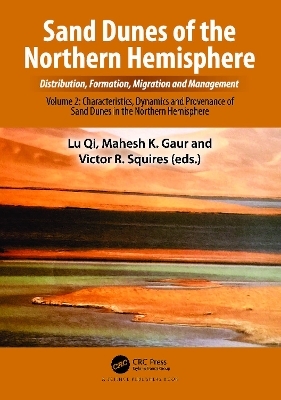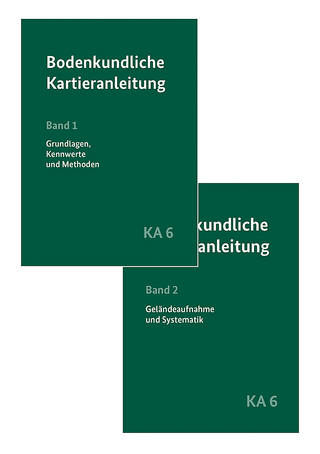
Sand Dunes of the Northern Hemisphere: Distribution, Formation, Migration and Management
CRC Press (Verlag)
978-1-032-26943-6 (ISBN)
Volume 2 of the book ‘Sand Dunes of the Northern Hemisphere’ is sub-titled Characteristics, Dynamics and Provenance of Sand Dunes in the Northern Hemisphere. It brings together a vast body of information and insight into sand dune and desert systems from North Asia, Central Asia, North Africa and the Middle East. Chapters from the Russian Federation include studies on dune systems within the permafrost zone and there is a case study from temperate zone dune system in coastal Japan.
Volume 2: Characteristics, Dynamics and Provenance of Sand Dunes in the Northern Hemisphere of 16 chapters in three Parts, focusses on Saharan Africa, Egypt, and Middle East and gives attention to sand mobility and encroachment with case studies from a number of countries where these matters are of concern. We also include chapters on the remote dunes in the permafrost zone and in the hyper-arid deserts of Iran. Case studies are used to highlight the characteristics of dunes and their interaction with humans in several widely divergent settings. Volume 2 concludes with some musing on the value of study of the past as key to the future and speculates on what the future might hold in the light of a warmer and drier Earth and a rise in sea level that threaten large tracts of low-lying land with marine incursions and destruction from storm surge.
PART 4 Sand Mobility and Encroachment
The seven chapters in this Part examine the real-world impact of sand encroachment and dune migration on people and their economic activities and the health, welfare and financial implications related to destruction of infrastructure, including human habitations.
PART 5 Sand Dune Landscapes Distribution, Formation and Management
Seven Case studies from several geographic regions in Africa, the Middle East, north-east Asia are presented here to demonstrate the underlying mechanisms in dune formation and the diverse approaches to their management. Human impacts such as sand mining, tourism development, combine with natural forces like climate variability to challenge the realization of an optimum management strategy.
PART 6 Concluding Thoughts: Coping with an Unknown Future from a Little-known Past
The two chapters in Part 6 have special roles. We are privileged to publish new research findings that are summarized here in Chapter 38 from extensive and detailed work conducted in the Kyzyl Kum, and Karakum sand seas of Central Asia. There is a strong belief that further study of the little-known past such as revealed in this study could unlock clues as to what a future Earth might look like. This leads on to speculation in Chapter 39 about the implications of what we already know about global change (not only climate change) and the impact of the Anthropocene on the dune systems, both inland and coastal. Sea level rise, marine incursions and an increase in extreme weather events will affect dune systems and sand seas on the Northern Hemisphere (and beyond).
Professor Lu Qi is Chief Scientist and Director of the Institute of Desertification Studies (IDS) in Beijing. The IDS is one of two such Institutes in the world. Dr. Lu has a PhD in Ecology from the Chinese Academy of Sciences, Beijing and is a specialist in Dryland Sustainable Development; Integrated ecosystem management/Desert Ecology and Combating desertification and Land degradation. He is the recipient of several prestigious awards: Three National Awards on Scientific & Technological Progress (Second Class, 2006/2009/2010) PRC National Award on International Science & Technology Cooperation (as Chinese Partner), 2008; Ningxia Hui Autonomous Region Award on Scientific & Technological Progress (First Class), 2008; and UNDP Best Practices Award on indigenous technology in combating desertification and mitigating the effect of drought. Dr. Lu is author/editor of 20 books notably A Study of Kumtagh Desert (in Chinese). Beijing: Science Press, 2012; Desert Plants in China (Illustrated Handbook, in Chinese). Beijing: China Forestry Publishing House, 2012; Rangeland Degradation and Recovery in China’s Pastoral Lands, CABI, UK, 2009; Studies on Populus euphratica Forest in Ejina Oasis. Beijing: Science Press, 2009. Regional Review of UNCCD Implementation and Best Practices in Asia and the Pacific—Case Studies from Australia, China, Mongolia, Thailand and Viet Nam. Beijing: Chinese Environmental Science Press, 2005 and 180 papers (mostly in Chinese). Dr. Mahesh K. Gaur is an Indian, who is working at the ICAR-Central Arid Zone Research Institute, Jodhpur, India as a Principal Scientist, since September 2020. He worked as Senior Scientist from 2012 to 2020. He specializes in aridlands geography and the application of satellite remote sensing, GIS and digital image processing for natural resources mapping, management and assessment. He also researches drought, desertification, land degradation, indigenous knowledge systems, and the socio-economic milieu of the Thar Desert of India. Prior to this, he has worked as an Associate Professor for more than 13 years with the Department of Higher Education, Government of Rajasthan State, India and has also worked at Sandhan, Jaipur, IIM Ahmedabad, IHS Hyderabad and IN-RIMT in various capacities. He has also completed sponsored studies for ICAR, ISRO, SAC, UGC, and ICARDA. He has published 50 research papers in national and international research journals, 50 conference papers, 45 book chapters, five popular articles, and eight books. He is a member of a number of national and international scientific organizations, such as the Association of American Geographers and the Society for Conservation Biology, and several editorial boards of journals. He has been to South Africa, Namibia and Costa Rica on academic assignments. He is awarded the Citizen Karamveer Award 2011 by iCONGO for working in the field of Higher Education, Environment and Technology Applications for Community Upliftment; the Millennium Award for working in the field of Environment, and prestigious recognitions by the UGC of India and Scientific Assembly of the International Committee on Space Research (COSPAR). Dr. Victor R. Squires is a Distinguished Guest Professor in the Institute of Desertification Studies, Beijing. He is an Australian who as a young man studied animal husbandry and rangeland ecology. He has a PhD in Rangeland Science from Utah State University, USA. He is a former Foundation Dean of the Faculty of Natural Resource Management at the University of Adelaide, Australia where he worked for 15 years after a 22 year career in Australia’s CSIRO. He is author/editor of 22 books on Drylands, Desertification, Ecological Restoration from such publishers as CRC Press, Springer, Routledge and Kluwer Academic and numerous research papers and invited book chapters. Since retirement from the University of Adelaide Dr. Squires was a Visiting Fellow in the East West Center, Hawaii, and an Adjunct Professor in the University of Arizona, Tucson and at the Gansu Agricultural University, Lanzhou, China. He has been a consultant to World Bank, Asian Development and various UN agencies in Africa, China, Central Asia and the Middle East. He was awarded the 2008 International Award and Gold Medal for International Science and Technology Cooperation by the Government of China and in 2011 was awarded the Friendship Award by the government of China. The Gold Medal is the highest award for foreigners. In 2015 Dr. Squires was honoured by the Society for Range Management (USA) with an Outstanding Achievement Award. Dr. Victor Squires was recognised in the 2021 Queen’s birthday Honours with a member of the Order of Australia (AM), for services to ecology, especially rangelands.
SAND MOBILITY AND ENCROACHMENT. Sand Dunes of the South-eastern Sahara of Morocco: Genesis Morphodynamic and Socioeconomic Impact of Sand Encroachment. Sand Dunes and Sand Encroachment in Moroccan Atlantic Sahara, Current Situation, Threat and Perspective. Sand Dunes in Sudan: A Commentary on Origin, Development and Threats Posed. Genesis, Distribution and Economic Impact of Dune Formations in Nigeria. Human and Climate Impacts on the Mobility of Nizzana Sand Dunes, Israel. Sand Dune Migration as a Source of Environmental Risk to El-Dakhala Oasis—The Western Desert—Egypt. Sand Dune Creeping and its Consequence on Cultivated Land, Development Projects and Protected Areas in Siwa Oasis, Western Desert, Egypt. SAND DUNE LANDSCAPES DISTRIBUTION, FORMATION AND MANAGEMENT. Geomorphology and Sustainable Management for the Sand Dunes of Kuwait. Barchan Dunes Properties in the Middle East. Barchan Dunes in Egypt: Distribution and Formation. Dune Massifs of Russia. Aeolian Sand Dunes in the Permafrost Zone of Russia. Deserts, Sand Dunes and Sand Seas of Iran. Sand Supply System to Dunes and Ecological Aspects in Tottori Sand Dunes, Japan, the Temperate Humid and Tectonically Active Area. CONCLUDING THOUGHTS: COPING WITH AN UNKNOWN FUTURE FROM A LITTLE-KNOWN PAST. The Karakum and Kyzylkum Sand Seas: Linking Geomorphology and Paleoclimate. Sand Dunes on a Warmer and Drier Earth: Uniting Perspectives, Synthesis and Conclusions.
| Erscheinungsdatum | 19.12.2023 |
|---|---|
| Zusatzinfo | 28 Tables, black and white; 72 Illustrations, color; 110 Illustrations, black and white |
| Verlagsort | London |
| Sprache | englisch |
| Maße | 178 x 254 mm |
| Gewicht | 730 g |
| Themenwelt | Naturwissenschaften ► Geowissenschaften ► Geografie / Kartografie |
| Naturwissenschaften ► Geowissenschaften ► Geologie | |
| Naturwissenschaften ► Geowissenschaften ► Hydrologie / Ozeanografie | |
| Technik ► Bauwesen | |
| Technik ► Umwelttechnik / Biotechnologie | |
| ISBN-10 | 1-032-26943-X / 103226943X |
| ISBN-13 | 978-1-032-26943-6 / 9781032269436 |
| Zustand | Neuware |
| Informationen gemäß Produktsicherheitsverordnung (GPSR) | |
| Haben Sie eine Frage zum Produkt? |
aus dem Bereich


